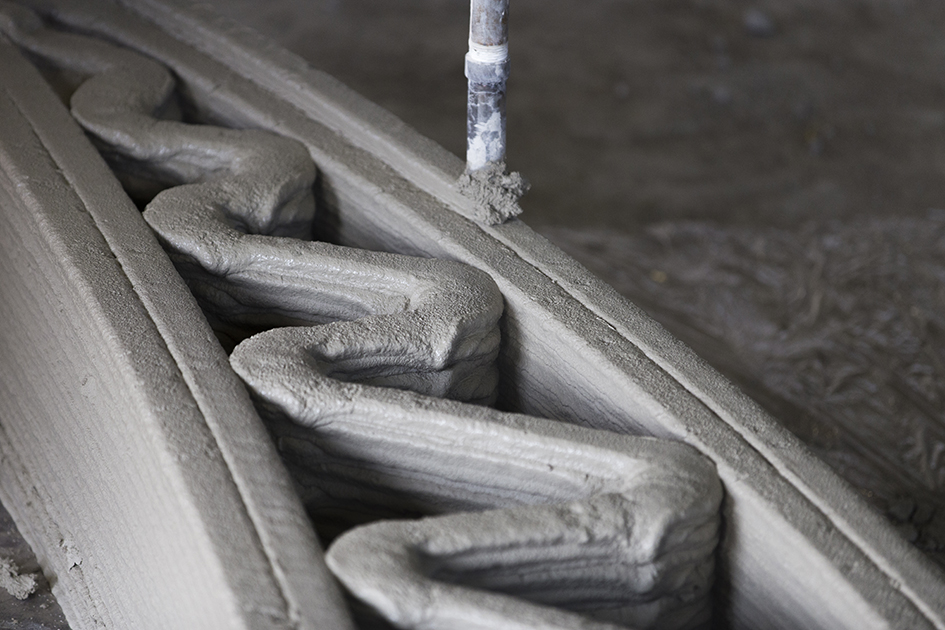It’s abundantly clear that fossil fuel-driven transport needs to be replaced, but more rail infrastructure is only as “green” as the materials and energy it uses. Currently under construction, the UK’s second high-speed rail network, HS2, may use concrete 3D printing technology to build concrete slabs on-site. The contractor, Skanska Costain STRABAG Joint Venture (SCS JV) claims that it will reduce the project’s carbon footprint by up to 50 percent.
Dubbing the technology “Printfrastructure”, SCS JV says that it will be using a mobile concrete 3D printer to 3D print elements of the rail network on-site, rather than transporting pre-cast slabs by road and lowering them into place via crane. This will allow for the construction of pieces in physically-restricted spaces, prevent disruption of public spaces and roadways that would be required by traditional methods, and make it possible to work during normal daylight hours, rather than at night, when the trains have stopped running.
SCS JV is a joint venture between Costain, a century-old British construction firm involved in the building of the Chunnel between France and England, and Skanska, a century-old Swedish company that’s renovated U.N. headquarters, built the World Trade Center Transportation Hub and MetLife stadium, among other notable projects. Their legacies should be ample evidence that they can take on HS2 and additive construction, but their legacies have also provided ample breeding ground for controversies and corruption.
Working on the project are ChangeMaker3D, a UK-based firm that collaborates with additive construction company CyBe, which has developed a mobile industrial robotic arm that deposits the firm’s own concrete material. ChangeMaker3D will be teaming with Versarien, a material expert, to incorporate graphene into the 3D printing process. So far, the use of graphene has not been used in additive construction, but the project team says, “Concrete with microscopic strands of graphene only several atoms thick running through it like stripes in a stick of rock replaces traditional steel to help drive improved site safety, greater construction flexibility, shorter build time and a smaller carbon footprint.”
This, in turn will reduce the carbon footprint by up to 50 percent, according to SCS JV, in part due to the lack of steel, cranes, and delivery trucks. Another factor contributing to reduced CO2 emissions is the type of pattern that can be produced with 3D printing. Unlike casting, additive construction is capable of making lattice structures that reduce total material use overall.
SCS JV Temporary Works Manager, Andrew Duck, said: “Automation enabled by Printfrastructure’s 3D reinforced concrete printing creates a factory-like environmental that delivers a high-quality product that both increases efficient use of materials, and reduces our carbon footprint. It is important that we give technologies such as Printfrastructure the opportunity to flourish because of the possibilities it offers the industry to make a step change in how projects are delivered.”
Numerous studies have suggested that tends to have a much lower carbon footprint than car or air transportation. During the construction phase, emissions may go up, however. China Dialogue suggested that coal use associated with steel and cement production increased two years in a row in 2018, with CO2 emissions thus going up. Though construction of high speed rail infrastructure can result in 58 t– 176 t of CO2 per km of line and year, an analysis by International Union of Railways determined “that the carbon footprint of high speed rail including operation, track construction and rollingstock construction is about 14 to 16 times less than transport by private car or airplane.”
Carbon emission in t CO2 due to construction per km of line and year for high speed rail. Image courtesy of International Union of Railways.
Carbon Footprint of traffic modes on route Valence – Marseille in France for high speed rail. Image courtesy of International Union of Railways.
The amount of greenhouse gasses that can be reduced, however, is determined by the energy source for electric trains. According to Railway Technology, “The high-speed trains between Spain and France run on renewable electrical energy and have a low carbon footprint, with every 100km travelled enabling an emission reduction of around 15kg of CO2.”
HS2 is also aiming to use alternative fuel sources at its construction sites, including hydrogen power. If the HS2 project really does deliver, then even the construction process may use fewer fossil fuels. That may be a big “if”. Not only do we have to see that graphene can be incorporated into the 3D printing process, but we also have to see the HS2 project actually stay on track. In the U.S., high speed rail projects have been regularly derailed by such large oil interests as the Koch brothers. In the U.K., the eastern leg of HS2 has been attacked as “unachievable”.
For those who believe rail may be the answer to decarbonizing transport, let’s hope that that’s not the case. Proof of concept trials for the additive component of HS2 are scheduled to begin in Spring 2022. Meanwhile, Changemaker 3D is also working with the British government to possibly 3D print wastewater distribution chambers in the country.
